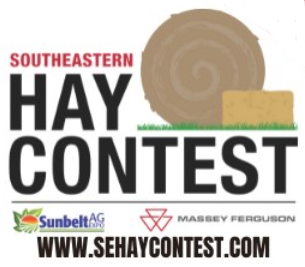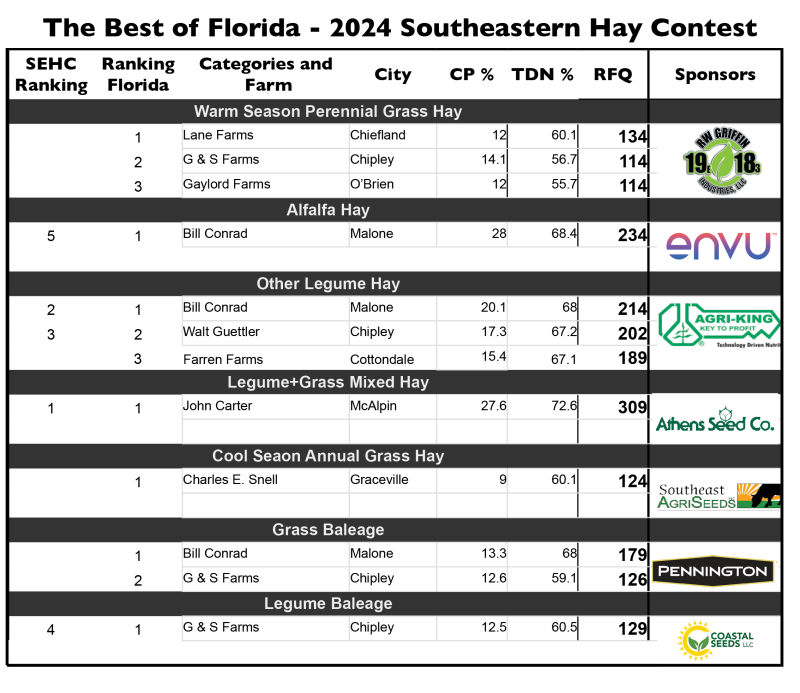 The 2024 Southeastern Hay Contest, held in partnership with Massey Ferguson and the Sunbelt Ag Expo, celebrated its 20th anniversary with a record 496 entries representing nine states! Florida participated with 55 entries from five counties: Levy (2), Suwannee (6), Washington (29), Jackson (17), and Holmes (1).
The 2024 Southeastern Hay Contest, held in partnership with Massey Ferguson and the Sunbelt Ag Expo, celebrated its 20th anniversary with a record 496 entries representing nine states! Florida participated with 55 entries from five counties: Levy (2), Suwannee (6), Washington (29), Jackson (17), and Holmes (1).
The overall grand prize winner was John Carter, from McAlpin, FL, with a grass-legume hay sample with an exceptional Relative Forage Quality (RFQ) of 309, total digestible nutrients (TDN) of 72.6%, and crude protein (CP) of 27.6%. To celebrate this achievement, Mr. Carter earned the use of a Massey Ferguson RK Series rotary rake or a DM Series Professional disc mower for the 2025 hay season, along with a $2,000 cash prize. During the awards ceremony at the Sunbelt Ag Expo on October 15, 2024, he was represented by his UF/IFAS Extension Agent, Erin Dasher. Two other Floridians were recognized in the “Other Legume Hay” category, with Bill Conrad (Jackson County) and Walt Guettler (Washington County) earning second and third places, respectively, for their perennial peanut hay.
–
Why Hay Quality Matters
High-quality forage is essential for livestock productivity. Better forage quality can significantly reduce feed costs, improve animal performance, and increase the profitability of livestock operations. Hay quality is measured by several parameters. RFQ is a key indicator that incorporates both digestibility and intake potential. This provides a comprehensive measure of how well livestock will perform on a given forage. Higher RFQ values mean better performance with less supplemental feeding.
Entering competitions like the Southeastern Hay Contest allows producers the opportunity to showcase their hard work and gain valuable insights into how their hay is turning out. The analysis results guide better management decisions, from fertilization to harvesting practices, into feeding or selling hay.
–
Issues with Moisture and Nitrates
What caught our attention this year is that about 27% of Florida’s hay samples were disqualified due to moisture levels or high nitrate concentrations. Most of those were in the baleage categories. This value is above historical averages, about 19% of the samples disqualified by moisture and 4% for nitrates. Florida’s weather conditions are challenging during the summer haying season, where the chances of having three consecutive days without rain during most of the summer are below 20%. That’s why baleage has been proposed as an alternative to dry hay, where forages can be cut, baled and wrapped within 2 days. Similar to silage, baleage preserves the forage through fermentation. However, if moisture levels not correct, the fermentation process will be affected. Too dry and little fermentation occurs, resulting in fungal growth, intensive heat and spoilage. Hight moisture will lead to clostridial fermentation with resulting high levels of butyric acid and ammonia. The acceptable range for moisture on baleage is between 40-65%. There are multiple ways and tools to measure moisture on hay and baleage, but the most accurate is drying. This can be done using a Koster tester, a microwave oven or even an air fryer. In the Ask IFAS SS-AGR-178 Methods of Forage Moisture Testing we explain how to measure the moisture content of your forage samples.
Another common issue the high nitrate concentration, where above 5,000 ppm can lead nitrate poisoning. This past year we had multiple calls from producers inquiring about nitrate, especially because of the prolonged spring drought, lasting until early July in some places. For the most part, nitrate accumulation results from a combination of stunted growth (drought or cold) with high nitrogen availability. The “normal” fertilization levels that most producers apply on our summer annuals seldom reach the level where nitrates would be a problem. However, heavy fertilization on annual forages followed by a drought can result in nitrate accumulation.
–
Take Control of Your Hay Quality
How does your hay measure up? Understanding hay quality is critical to making informed feeding decisions. Your local Extension office can help with sampling and interpreting results. Participating in contests like the Southeastern Hay Contest is not just about winning; it’s a way to learn more about your forage and improve its quality over time.
To make the most of your forage analysis, check out the UF/IFAS Hay Balancer tool, developed by Dr. DiLorenzo. This tool helps tailor cow supplementation based on forage quality, saving you money and improving animal performance.
Join the Challenge! Contact your local county extension agent and start sampling your hay today to aim for the top in next year’s contest. Quality forage doesn’t just pay off in competitions—it pays off on your farm.
- 2025 Southeastern Hay Contest Sets New Records - October 24, 2025
- 2025 Cool-Season Forage Official UF/IFAS Variety Trial Results - September 5, 2025
- Revisiting Crop–Livestock Integration in the Southeastern United States - September 5, 2025

